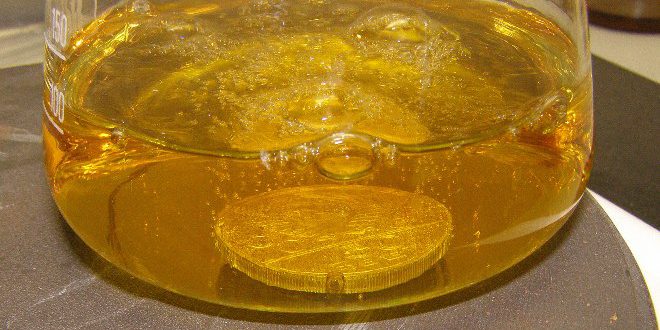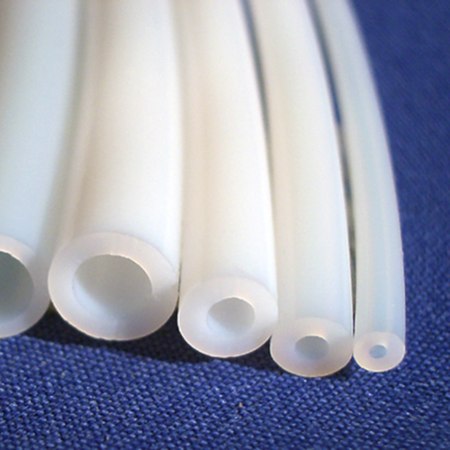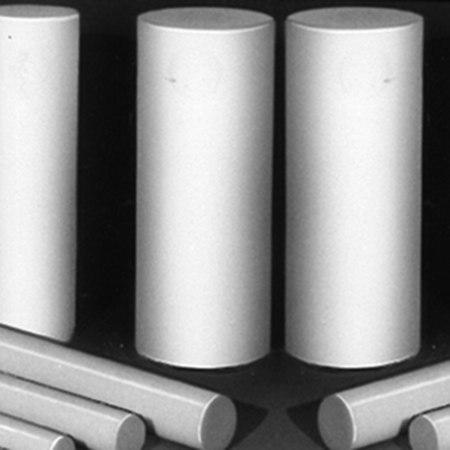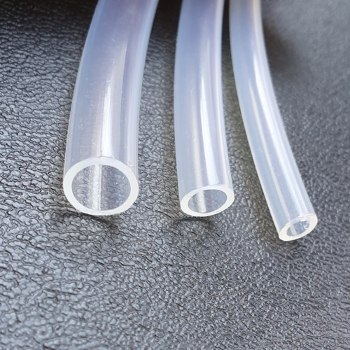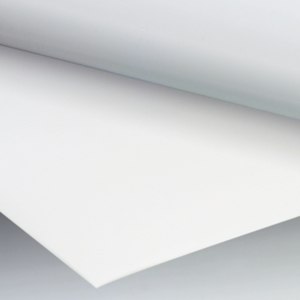Industrial Applications and Compatible Hose Technology
Many people have heard the term aqua regia, but what exactly is this special ‘water’ and what is it made of? The name “aqua regia” (literally “royal water”) refers to its ability to dissolve the “royal” metals gold and platinum. Another, less common name is royal acid.
When mixed, these acids produce nitrosyl chloride (NOCl) and chlorine radicals, which are responsible for dissolving the metal. Pure concentrated nitric acid cannot dissolve gold alone; only when chloride ions from the hydrochloric acid are present can the oxidised gold ions form complexes, resulting in tetrachloroauric acid (HAuCl₄).
In addition to gold and platinum, metals such as rhenium, osmium, rhodium, iridium, palladium and mercury can also be dissolved by aqua regia. Metals like zirconium, hafnium, niobium, tantalum, titanium and tungsten form a passivation layer on their surfaces and therefore do not dissolve in this solution at room temperature. Silver does not dissolve either, as it forms an insoluble layer of silver chloride.
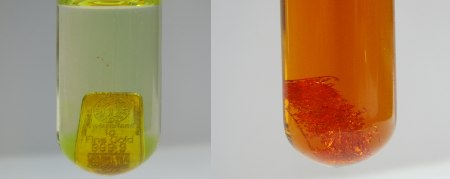
Aqua regia can only be used for a short time since nitrosyl chloride, chlorine and nitrous gases (a mix of various nitrogen oxides) decompose or escape over time. Therefore, it must be freshly prepared before each use.
Applications of Aqua Regia
Aqua regia is mainly used to produce tetrachloroauric acid, which serves as an electrolyte in the so-called Wohlwill process, an electrochemical refining method for non-ferrous and precious metals that achieves gold purities of over 99.99 percent.
In Germany, aqua regia digestion is standardised according to DIN EN 13346, which specifies the determination of elements such as cadmium, chromium, copper, mercury, nickel, lead and zinc in sewage sludge and soils. The related standard DIN EN 13657 covers the determination of heavy metals in biowaste, landfills and waste wood. These procedures may differ in other countries according to local regulations. During the digestion process, samples are first dried and ground, then treated with aqua regia and heated to boiling temperature for two hours. The dissolved metals can then be measured.

Another use for aqua regia is to estimate the fine gold content in jewellery. For this, several scratch samples are taken from the gold surface and exposed to solutions of varying concentrations.
This makes it relatively easy to detect so-called ‘fake gold’. Aqua regia is also used in metallography to etch the surface of metals or alloys to make the crystalline structure visible.
Materials for Working with Aqua Regia
Aqua regia is a strongly corrosive acid and also an oxidiser. Therefore, special care is required when handling it. This corrosive mixture attacks most materials — only fluoropolymer-based plastics are resistant. Laboratory containers for preparing aqua regia and plastic tubes for transport are made from these materials.
Fluorinated Homopolymers: PCTFE and PTFE
Various groups of fluoropolymers offer resistance to aqua regia. One such group is homopolymers, meaning these polymers consist of only one type of monomer. This group includes polytetrafluoroethylene (PTFE) and polychlorotrifluoroethylene (PCTFE). The monomer for PTFE is tetrafluoroethylene; PCTFE is produced by polymerising 1-chloro-1,2,2-trifluoroethylene. The difference lies in one of the four fluorine atoms being substituted by a chlorine atom.
PCTFE, developed in 1934, was the earliest fluoropolymer. It is a semi-crystalline thermoplastic with the highest hardness, strength and rigidity among fluoropolymers. It can be used in a temperature range from –240 °C to +205 °C and is mainly processed into semi-finished products and foils. Due to its stiffness, it is unsuitable for plastic hoses.
PTFE, better known by its trade name Teflon®, was discovered in 1938. Initially, high production costs and limited applications restricted its use. In 1943, during the Manhattan Project, PTFE-coated equipment was used to handle large quantities of highly corrosive uranium hexafluoride for uranium enrichment. This led to broader civilian use afterwards.
PTFE can be used in a temperature range from –200 °C to +260 °C. In sealing technology, it is used as PTFE tape, sealing rings and bellows.
Thanks to its corrosion resistance and non-stick properties, it is also a popular coating material for tanks and pipelines. Another important field is hose technology: fluoropolymer hoses are widely used in the chemical, pharmaceutical and medical sectors, as well as the food industry, due to their chemical and thermal resistance, negligible gas permeability, mechanical flexibility and sterilisation capability.
Fluorinated Copolymers: ETFE, ECTFE, FEP, PFA and MFA
The second group consists of copolymers, made from two different monomers. Examples include ethylene-tetrafluoroethylene (ETFE), ethylene-chlorotrifluoroethylene (ECTFE), perfluoroethylene-propylene (FEP), poly[tetrafluoroethylene-perfluoro(alkoxy vinyl ether)] (PFA) and modified PFA (MFA).
ETFE and ECTFE differ, like PTFE and PCTFE, by substitution of a fluorine atom with chlorine. Both are polymerised from tetrafluoroethylene and ethylene or chlorotrifluoroethylene and ethylene, respectively. They are partially fluorinated, have lower density than PTFE, and offer high transparency and light transmission while showing similar chemical resistance. ETFE is mainly used in architecture for roofs, walls and façades — for example, the roof of the Allianz Arena in Munich is made of ETFE film. ECTFE is used as a coating for pipes and tanks and as a glass replacement for laboratory items in chemical applications.
FEP, obtained by copolymerising tetrafluoroethylene and hexafluoropropylene, is a fully fluorinated polymer, meaning all hydrogen atoms are replaced by fluorine. Of all fluoropolymers, it offers the widest thermal working range from –250 °C to +205 °C. In hose technology, it is used for transparent plastic hoses with non-porous, anti-adhesive inner walls suitable for all sterilisation methods.
PFA and MFA are fully fluorinated copolymers of tetrafluoroethylene and perfluoroalkoxyethylene. They differ in the length of the ether group. Unlike PTFE, PFA is thermoplastically processable, has better non-stick properties, higher chemical resistance, but slightly lower scratch resistance. An important area of application for vessels and plastic tubing made from PFA is trace element analysis. Since PFA, unlike commonly used materials such as glass, quartz, polyethylene and polypropylene, shows less interaction with sample and reference solutions, using PFA vessels and hoses results in more reliable analytical results.
MFA is valued for its chemical, thermal and mechanical stability and its excellent light transmission. MFA tubing is mainly used in the food, pharmaceutical and medical industries due to their FDA compliance.
Perfluoroelastomer FFKM
The third group of fluoropolymers resistant to aqua regia is perfluoroelastomers, abbreviated as FFKM. These perfluorinated elastomers have a similar chemical composition and exhibit outstanding chemical and thermal stability, constant elasticity and low outgassing. Due to the complex manufacturing process, perfluoroelastomers are expensive, like other fluoropolymers. FFKM is primarily used as a sealing material in the form of O-rings.
All fluoropolymers offer excellent chemical resistance — they withstand even this powerful acid mixture, which is capable of dissolving gold and platinum.
Image sources: Cover image | © Andres Punning, CC BY-SA 3.0 https://creativecommons.org/licenses/by-sa/3.0, via Wikimedia Commons Gold dissolving in aqua regia (left and right image) | © Daniel Grohmann, CC BY-SA 3.0 https://creativecommons.org/licenses/by-sa/3.0, via Wikimedia Commons Platinum dissolving in aqua regia (left and right image) | © Andres Punning, kuningveega solgutas Urmas Johanson, CC BY-SA 3.0 https://creativecommons.org/licenses/by-sa/3.0, via Wikimedia Commons
 Reichelt Chemietechnik Magazine
Reichelt Chemietechnik Magazine
